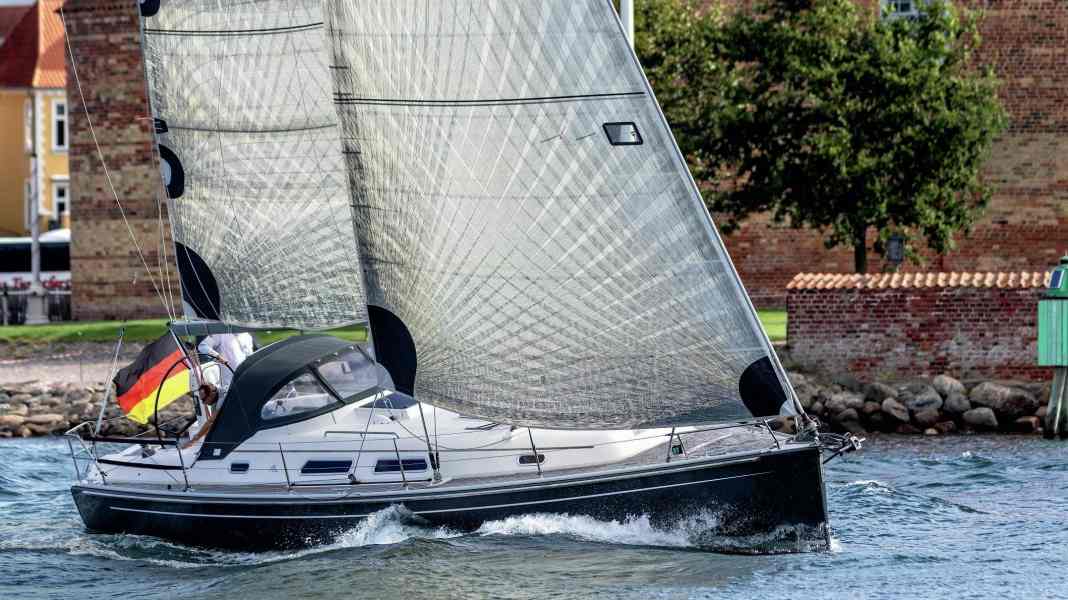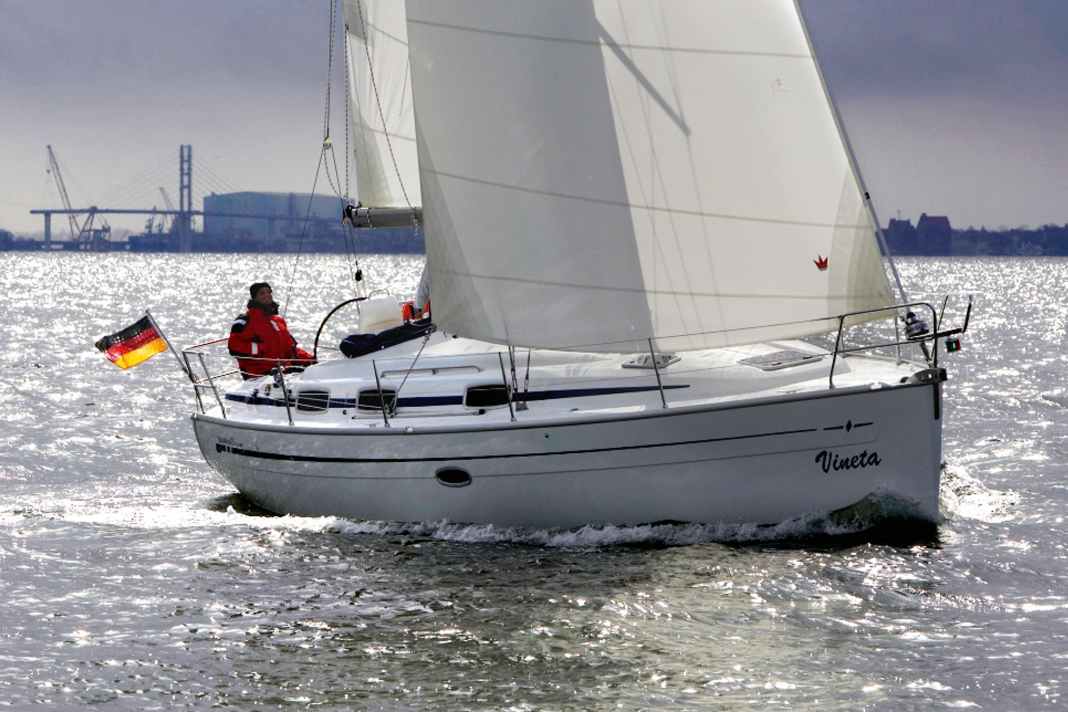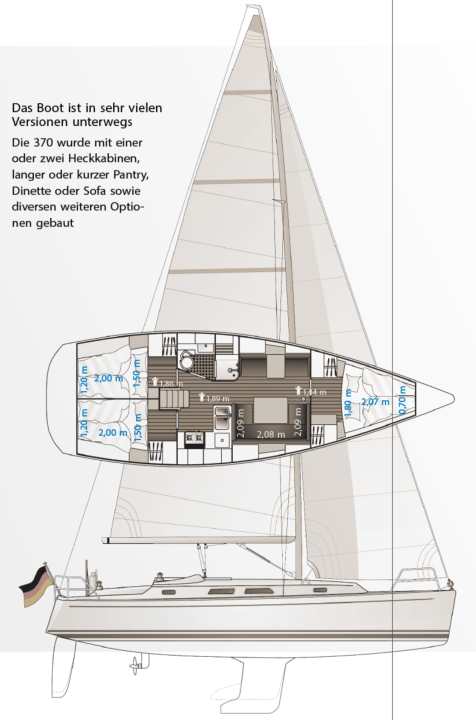Hanse 370: Hanses Hammer with potential to become a GRP classic in a used boat test

It's hard to believe. It cost around 108,000 euros new at the beginning of its life cycle in 2005, and today it is on the market for up to 130,000 euros. More expensive used than new is a development, albeit a theoretical one, because it does not take into account the loss of purchasing power and price fluctuations in the shipyards, which is usually reserved for only a few types.
Regardless of this, the boat was really good back then - and it still is today. In 2005, the Hanse 370 marked an important step into the modern age for Germany's second-largest shipyard at the time. The new line appeared fresher, more dynamic and more independent than the previous generation. The 370 was based on the 371, which was the first independent development from Greifswald; until then, only older moulds from other manufacturers had been used.
Used boat profile Hanse 370
- Profile: Hanse 370
- Design engineer: Judel/Vrolijk & Co
- Dimensions: 11.25 x 3.75 m
- Built: from 2005-2010
- Quantity: approx. 600
- New price 2005: 108.000 €
- Used price: approx. 80,000-130,000 €
But what can the Hanse 370 from the second product generation do today, what has endured, where are the shortcomings and finally: How good and recommendable is the Hanse 370 as a used boat?
Visually, she still looks contemporary with her fairly wide, flat, semi-open stern, striking superstructure, ultra-modern underwater hull and tall, slim 9/10 rig. What is different at first glance is that the bow sections are now fuller, the hulls gain even more space below deck thanks to chines, and stern hatches increase cockpit comfort. Additional aft rigging allows for larger headsails, which is particularly useful when using a self-tacking jib. Double wheels create good seating positions and allow easy passage. But are the advantages significant?
More used boats in the test:
Michael Wienecke's build number 318 from Stöckte at her summer home harbour in Sønderborg, Denmark, is available to us for the used boat test. An example that is probably the best Hanse 370 under the sun thanks to its outstanding condition and its neat and clever optimisations. The former stand builder bought the ship in 2006 and has since had it repainted. He maintains the surfaces meticulously and with dedication ("It's my second hobby"). The frequent sailor, who has already travelled as far as the Mediterranean with his "fanta ... four", has fitted protective plastic surfaces or niro angles. Rubber mats in the storage compartments provide protection from heavy equipment. Below deck, Wienecke has revitalised unused storage spaces, installed a pull-out Nespresso machine, renewed the upholstery and, above all, kept everything meticulously clean. It is a real feast for the eyes.
The "fanta ... four" may no longer be a typical Hanse 370 due to its particularly high quality, but it is an excellent example of how good a used boat can be or become in knowledgeable and willing hands.
The competition is fierce and varied. The examples





As if the boat didn't provide enough reason to be happy, Sønderborg Bay presented itself from its best side on the test day with 14 to 16 knots, sunshine and high temperatures. 6.3 to 6.5 knots and a tacking angle of less than 90 degrees are possible at the cross, good values that can easily be increased with more homogeneous waves. The speed quickly climbs to the end of seven knots. The good results are also thanks to the clean, five-year-old laminate cloths from Jan Segel in Großenbrode. In use is a slightly overlapping genoa on rails bolted to the deck, which the shipyard installed at the time even if the customer had not ordered a genoa.
The alternative is a self-tacking jib, but below ten knots of true wind this causes the boat to weaken and loses a lot of efficiency even on slightly choppy courses. The slender sail then opens up at the top, and barber haulers are a good idea here. And generally a sheet with as little stretch as possible, as it covers many metres on the long way from the clew via the track up into the mast and down and back into the cockpit and can stretch so quickly. Anyone sailing a self-tacking jib is particularly well advised to use a laminate or membrane sail, otherwise it will hardly be possible to stabilise the leech, despite vertical battens.
With a genoa, the Hanse 370 is excellent underway, the reefing limit is around 15 to 16 knots of true wind, a decent value. The low-drag rotary vane prop also ensures good speed on the test ship, but the external bow thruster of the test ship then counteracts the positive effect.
Excellent under sail and can also motor
The Hanse 370 turns quickly, takes waves cleanly, and steering it is a poem thanks to the slip- and play-free gimbal system from the manufacturer Jefa. On the "fanta ... four", the owner has installed a 140 centimetre diameter plastic wheel from the manufacturer Carbonautica, the maximum size that can be realised. This measure enables relaxed sitting on the cockpit coaming without long arms and sensitive steering. The helmsman finds a good sitting position in front of the rather massive-looking wheel column and can look into the headsail lines and onto the waves unhindered and with little fatigue. If necessary, he can put the large wheel between his legs and support himself with the front wheel on the column.
The 1:6 mainsheet works on a traveller in the cockpit, which was an extra at the time and is the right choice for single-handed suitability and efficiency. The aft stay tackle is conveniently operated with a 1:16 tackle. The optional larger 46 mm winches make it easy to operate the genoa sheets. Everything is fine, the only thing we would like to see are line-adjustable centreboards, but these can be retrofitted quite easily. Another striking feature is the rather small cockpit with 1.60 metre long thwarts compared to more modern designs.
She can also motor: at full throttle, the Hanse reaches 7.3 knots, at cruising speed it is just under six. The noise level is kept within tolerable limits. The noise level is 76 decibels (A) in the aft cabin and 70 in the saloon. The boat was also available with a larger 40 hp power unit from Yanmar.
Layout, headroom, comfort dimensions and visual features
The other impressions below deck are also pleasant: The optional cherry finishing wood is used quite sparingly, white surfaces dominate, which was a new style in series production at the time and is now common practice. On the test boat, a certain discolouration of the wood from a reddish to a slightly yellowish hue is visible. The saloon table was only pinned to the floor on early build numbers and could be torn loose, a point that interested parties should check. The same applies to the bilge. In some build numbers, the laminating was somewhat unclean, as evidenced by sharp-edged laminate protrusions and individual free-standing fibres. There are also some unsightly spots due to adhesive and other residues that have not been removed. Not that there is much that can be done about this apart from a treatment with sandpaper and topcoat if you consider this visual imperfection under the floorboards to be a blemish.
Our test boat, on the other hand, shows its best side. The floorboards don't make a sound, Master Wienecke has laid foam rubber and screwed it down well, very pleasant. As a first-time buyer, he had the choice of a sofa or a dinette. The chosen second table, measuring 60 by 70 centimetres, serves as an office and navigation corner. Instead of two cabins in the stern, there is only one and a huge cockpit, which can also be accessed via the galley through a small door. This also makes it suitable as a directly accessible storage space. The locker has so much volume that it should be subdivided. Even an emergency berth could be installed there.
The Hanse 370 was ahead of its time below deck
The galley line is longer in the version with only one cabin in the rear, the kitchen has standard dimensions with more work surface, storage and standing space than the three-cabin version. The long side of the L-shaped galley, which can be ventilated via the superstructure windows and of course the centre hatch and companionway, measures a full 2.30 metres. All windows in the cabin roof sides can be opened, a real plus for good cross ventilation, which many shipyards unfortunately do without. Another nice feature is that the cooker can be swivelled far enough in both directions for normal heeling angles and can be covered with a segment of the work surface. The refrigerator developed by Hanse and Isotherm can be opened from above and from the side. However, the compressor is difficult to reach and does not get enough air, so of course our optimiser has installed an air duct in the saloon. What is still missing is the obligatory splash guard for the saloon sofa, but this can easily be retrofitted.
The Hanse 370 is at the cutting edge in terms of space and ergonomic dimensions, which is reflected in the headroom, the cabin sizes, the berth dimensions and, in particular, the very spacious wet room. The shower is completely separable, which was by no means a matter of course in 2005.
The Hanse 370 was also offered laminated in epoxy resin, which cost 6,844 euros extra at the time and, in addition to osmosis resistance, stood for greater strength and better bonding. In theory, a used boat laminated in this way should therefore be classified as higher quality.
Timeless lines, solid substance and good features. The 370 has what it takes to become a GRP classic
There are various other specific points that a prospective buyer should pay attention to: The initial fittings of some product groups were of fairly basic quality and were not aimed at long durability or quality. The previous owner should have already replaced the cushions, mattresses and the tubes of the faeces system, otherwise this should help to reduce the purchase price. The sails should not be older than five years. Sprayhoods, cake stands and tarpaulins, on the other hand, should last at least ten years. Owners of early build numbers have also reported that the Simrad displays used for a while tended to leak and the autopilot could sometimes squeak.
Otherwise, the typical issues are important for a used boat buyer. The engine should be serviced regularly and according to the manufacturer's instructions, and the saildrive sleeve should be replaced after about ten years. A test drive is generally advisable, as is an inspection on land. The Hanse 370 has been built around 600 times, which is why it is often found on the used boat market. The Hanse 375, which was built until 2016, is a comparable model. The main differences are in the cockpit, the stern and a more modern window line.
The Hanse 370 is usually offered for 80,000 to 130,000 euros. Favourable examples are usually found in the Mediterranean or occasionally come from charter stocks, where the ship was much less common than comparable yachts from the other large series manufacturers Beneteau, Jeanneau or Bavaria.
All in all, the boat sails well, can be effectively upgraded with a genoa or code zero in terms of light weather characteristics and is a pleasure to steer. The substance makes a high-quality and resilient impression, the finish and installations are also fine. With care and attention, the Hanse 370 will become a long-lasting GRP classic. With various construction and design features, the Hanse 370 was ahead of its time. And that's why it doesn't look outdated today, but has arrived.
The measured values for testing the Hanse 370



The Hanse 370 in detail

Technical data of the Hanse 370
- Design engineer: Judel/Vrolijk & Co.
- CE design category: A
- Torso length: 11,25 m
- Total length: 11,35 m
- Waterline length: 10,05 m
- Width: 3,75 m
- Draught/alternative: 1,95/1,60 m
- Mast height above WL: 17,77 m
- Theoretical torso speed: 7.70 kn
- Weight: 6,8 t
- Ballast/proportion: 2,3 t/36 %
- Mainsail: 42,5 m2
- Self-tacking jib: 28,6 m²
- machine (Yanmar): 21 kW/29 hp
- Fuel tank: Stainless steel, 40 litres
- Fresh water tank: Plastic, 300 litres
- Holding tank: Plastic, 40 litres
Construction method
Hand lay-up method. Hull sandwich above the waterline, balsa wood core. Floor assembly made of GRP. Deck balsa sandwich. Bulkheads laminated. Deck-hull connection glued and screwed. First models laminated with epoxy resin
Model history
The Hanse 370 rolled off the production line between 2005 and 2010. Derivative with the same hull built from 2010 to 2016 (Hanse 375)
You should pay attention to this
The optional genoa rails can lift the deck at least to starboard, where a joist should be installed. Leaks have appeared on some models. Otherwise, check the usual areas: Gelcoat, teak deck, deck-hull connection (especially at the transom), hairline cracks on deck. Leaking fittings are critical for the sandwich deck with balsa core
Price and shipyard
- New price 2005: 108.000 €
- Used price: 80.000-130.000 €
Shipyard
Hanseyachts, Greifswald
YACHT review of the Hanse 370
The Hanse 370 is still a modern, comfortable boat that sails well. A real tip for used boat buyers. The usual market price range is reasonable
Design and concept
- + Balanced design
- + Space and layout
Sailing performance and trim
- + Easily retrievable potential
- + Suitable for one hand
- + mainsheet guide for selection
Living and finishing quality
- + Bright and airy design
- + Large separate shower
- - Detail defects possible
Equipment and technology
- + Good wheel steering system
- - Small winches as standard

